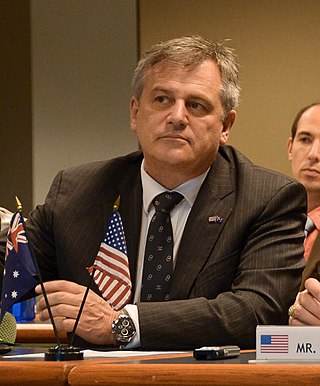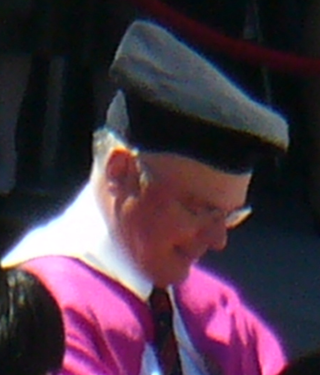Related Research Articles

Eli Yablonovitch is an American physicist and engineer who, along with Sajeev John, founded the field of photonic crystals in 1987. He and his team were the first to create a 3-dimensional structure that exhibited a full photonic bandgap, which has been named Yablonovite. In addition to pioneering photonic crystals, he was the first to recognize that a strained quantum-well laser has a significantly reduced threshold current compared to its unstrained counterpart. This is now employed in the majority of semiconductor lasers fabricated throughout the world. His seminal paper reporting inhibited spontaneous emission in photonic crystals is among the most highly cited papers in physics and engineering.
Sir David Neil Payne is a British professor of photonics who is director of the Optoelectronics Research Centre at the University of Southampton. He has made several contributions in areas of optical fibre communications over the last fifty years and his work has affected telecommunications and laser technology. Payne’s work spans diverse areas of photonics, from telecommunications and optical sensors to nanophotonics and optical materials, including the introduction of the first optical fibre drawing tower in a university.
Ernst Adolph Guillemin was an American electrical engineer and computer scientist at the Massachusetts Institute of Technology who spent his career extending the art and science of linear network analysis and synthesis. His nephew Victor Guillemin is a math professor at MIT, his nephew Robert Charles Guillemin was a sidewalk artist, his great-niece Karen Guillemin is a biology professor at the University of Oregon, and his granddaughter Mary Elizabeth Meyerand is a Medical Physics Professor at the University of Wisconsin-Madison.
Xi-Cheng Zhang is a Chinese-born American physicist, currently serving as the Parker Givens Chair of Optics at the University of Rochester, and the director of the Institute of Optics. He is also the Chairman of the Board and President of Zomega Terahertz Corporation.

James S. Harris is a scientist and engineer and fellow of IEEE, American Physical Society and Optical Society of America. His research primarily deals with optoelectronic devices and semiconductor material research.
Ann Catrina Coleman is a Scottish electrical engineer and professor at the University of Texas at Dallas specialising in semiconductor lasers.
Ilesanmi Adesida is a Nigerian American physicist of Yoruba descent. He has been the provost at Nazarbayev University in Astana, Kazakhstan, from September 2016.

Amnon Yariv is an Israeli-American professor of applied physics and electrical engineering at Caltech, known for innovations in optoelectronics. Yariv obtained his B.S., M.S. and PhD. in electrical engineering from University of California, Berkeley in 1954, 1956 and 1958, respectively.
Graham Clifford Goodwin is an Australian Laureate Professor of Electrical Engineering at the University of Newcastle, Australia.

Ian Hugh White is a British engineer. His previous roles include vice-chancellor of the University of Bath, Master of Jesus College, Cambridge, deputy vice chancellor of the University of Cambridge, van Eck Professor of Engineering, and head of the Photonic Research Group, comprising CMMPE, Centre for Photonic Systems, and Photonics and Sensors, in the Cambridge University Engineering Department.

Alexander Zelinsky is an Australian computer scientist, systems engineer and roboticist. His career spans innovation, science and technology, research and development, commercial start-ups and education. Professor Zelinsky is Vice-chancellor and President of the University of Newcastle joining the university in November 2018. He was the Chief Defence Scientist of Australia from March 2012 until November 2018. As Chief Defence Scientist he led defence science and technology for Australia's Department of Defence.
David Skellern is an Australian electronic engineer and computer scientist credited, along with colleagues, for the first chip-set implementation of the IEEE 802.11a wireless networking standard.
Chennupati Jagadish, an Indian-Australian physicist and academic, is the President of the Australian Academy of Science, and a Distinguished Professor of Physics at the Australian National University Research School of Physics. He is head of the Semiconductor Optoelectronics and Nanotechnology Group which he established in 1990. He is also the Convener of the Australian Nanotechnology Network and Director of Australian National Fabrication Facility ACT Node.

David A. B. Miller is the W. M. Keck Foundation Professor of Electrical Engineering at Stanford University, where he is also a professor of Applied Physics by courtesy. His research interests include the use of optics in switching, interconnection, communications, computing, and sensing systems, physics and applications of quantum well optics and optoelectronics, and fundamental features and limits for optics and nanophotonics in communications and information processing.
John Edwin Midwinter was a British electrical engineer and professor, who was President of the Institution of Electrical Engineers from 2000 to 2001.
Ranjan Kumar Mallik is an Indian electrical and communications engineer and a professor at the Department of Electrical Engineering of the Indian Institute of Technology, Delhi. He held the Jai Gupta Chair at IIT Delhi from 2007 to 2012 and the Brigadier Bhopinder Singh Chair from 2012 to 2017. He is known for his researches on multiple-input multi-output systems and is an elected fellow of all the three major Indian science academies viz. Indian Academy of Sciences, Indian National Science Academy, and The National Academy of Sciences, India. He is also an elected fellow of The World Academy of Sciences, Indian National Academy of Engineering, and The Institute of Electrical and Electronics Engineers, Inc.
Marcela Bilek is a Professor of Applied Physics and Surface Engineering at the University of Sydney, Australia. Her research interests focus on the use of plasma related methods to synthesise thin film materials and modify surfaces and interfaces. She was named Fellow of the American Physical Society in 2012 and Fellow of the Institute of Electrical and Electronics Engineers (IEEE) in 2015 for contributions to the science and application of plasma processes for materials modification and synthesis.
David Abramson is an Australian computer scientist. He has been Director of the Research Computing Centre at the University of Queensland, Australia, since 2012. He has been involved in computer architecture and high performance computing research since 1979.

Mona Jarrahi is an Iranian Engineering professor at the University of California, Los Angeles. She investigates novel materials, terahertz/millimeter-wave electronics and optoelectronics, microwave photonics, imaging and spectroscopy systems.
Stephen R. Forrest is an American physicist and academic with contributions to organic electronics and optoelectronics. He is the Peter A. Franken Distinguished University Professor of Engineering and Paul G. Goebel Professor of Electrical Engineering at the University of Michigan. He has worked in organic light-emitting diodes (OLEDs), organic solar cells, and organic thin-film transistors.
References
- ↑ "Professor Lorenzo Faraone | Australian Academy of Science". www.science.org.au. Retrieved 29 May 2019.
- ↑ "Dr Lorenzo Faraone". Australian Honours Search Facility. Retrieved 21 January 2024.
- ↑ "2015 elevated fellow" (PDF). IEEE Fellows Directory. Archived from the original (PDF) on 30 March 2015.